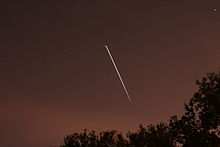
An orbital pass (or simply pass) is the period in which a spacecraft is above the local horizon, and thus available for line-of-sight communication with a given ground station, receiver, or relay satellite, or for visual sighting. The beginning of a pass is termed acquisition of signal (AOS); the end of a pass is termed loss of signal (LOS). The point at which a spacecraft comes closest to a ground observer is the time of closest approach (TCA).
Timing and duration
The timing and duration of passes depends on the characteristics of the orbit a satellite occupies, as well as the ground topography and any occulting objects on the ground (such as buildings), or in space (for planetary probes, or for spacecraft using relay satellites). The longest duration ground pass will be experienced by an observer directly on the ground track of the satellite. Path loss is greatest toward the start and end of a ground pass, as is Doppler shifting for Earth-orbiting satellites.
Satellites in geosynchronous orbit may be continuously visible from a single ground station, whereas satellites in low Earth orbit only offer short-duration ground passes (although longer contacts may be made via relay satellite networks such as TDRSS). Satellite constellations, such as those of satellite navigation systems, may be designed so that a minimum subset of the constellation is always visible from any point on the Earth, thereby providing continuous coverage.
Prediction and visibility
Main article: List of satellite pass predictorsA number of web-based and mobile applications produce predictions of passes for known satellites. In order to be observed with the naked eye, a spacecraft must reflect sunlight towards the observer; thus, naked-eye observations are generally restricted to twilight hours, during which the spacecraft is in sunlight but the observer is not. A satellite flare occurs when sunlight is reflected by flat surfaces on the spacecraft. The International Space Station, the largest artificial satellite of Earth, has a maximum apparent magnitude of –5.9, brighter than the planet Venus.
See also
- Ground track, the path on the surface of the Earth directly below a satellite
- Satellite revisit period, the time elapsed between observations of the same point on Earth by a satellite
- Satellite watching, as a hobby
References
- ^ "AOS, TCA, and LOS". Northern Lights Software Associates. Retrieved 17 November 2015.
- ^ Wood, Lloyd (July 2006). Introduction to satellite constellations: Orbital types, uses and related facts (PDF). ISU Summer Session. Retrieved 17 November 2015.
- ^ Del Re, Encrico; Pierucci, Laura, eds. (6 December 2012). Satellite Personal Communications for Future-generation Systems. Springer. p. 19. ISBN 978-1447101314. Retrieved 17 November 2015.
- Richharia, Madhavendra (2014). Mobile Satellite Communications: Principles and Trends (Second ed.). Wiley. pp. 106–107. ISBN 978-1118810064. Retrieved 17 November 2015.
- Montenbruck, Oliver; Eberhard, Gill (2012). Satellite Orbits: Models, Methods, and Applications. Springer. p. 229. ISBN 978-3642583513. Retrieved 17 November 2015.
- Dickinson, David (July 11, 2013). "How to Spot and Track Satellites". Universe Today. Retrieved 17 November 2015.
- "ISS Information - Heavens-above.com". Heavens-above. Retrieved 2007-12-22.
- "HORIZONS Web Interface". Solar System Dynamics. Jet Propulsion Laboratory. Retrieved 13 July 2016.
| Spaceflight | |||||||
|---|---|---|---|---|---|---|---|
| General | |||||||
| Applications | |||||||
| Human spaceflight |
| ||||||
| Spacecraft | |||||||
| Destinations | |||||||
| Space launch | |||||||
| Ground segment | |||||||